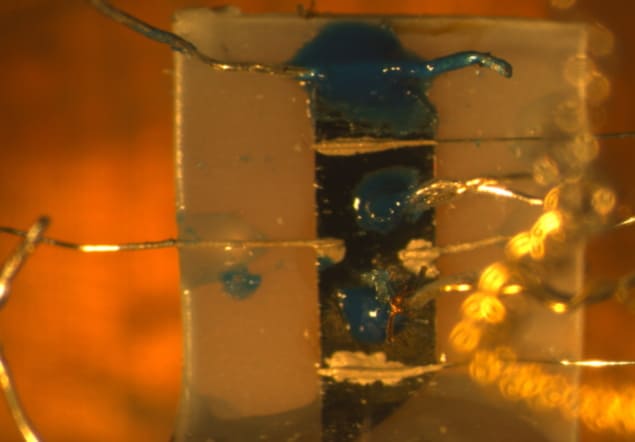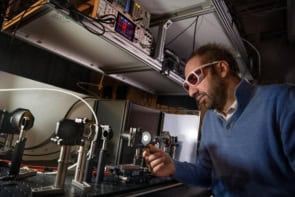
Cool a material below its superconducting transition temperature and you’d expect it to start conducting electricity without resistance and expelling magnetic fields. But an international group of physicists has found that a certain kind of iron-based material doped with negative charges does the opposite at around the same temperature – producing spontaneous magnetic fields and retaining resistance when chilled. The researchers say that the results point to a new state of matter in which electrons flow in correlated groups of four, rather than two.
According to the Bardeen-Cooper-Schrieffer (BCS) theory, superconductivity occurs when electrons get together to form what are known as Cooper pairs. Whereas in a vacuum two electrons would repel each other, when moving through the crystal lattice of a superconducting material, one of these particles shifts the positions of surrounding atoms to leave a small region of positive charge. This attracts the second electron to create the pair.
The creation of many such pairs yields a collective condensate, which results in frictionless electron flow. This occurs below a certain temperature – the superconducting transition temperature (Tc) – at which point atoms lack the thermal energy to break up the pairs.
The formation and condensation of Cooper pairs involves breaking what is known as gauge U(1) symmetry. But some more complex superconducting materials have been shown experimentally to also break temporal symmetry. This occurs because below a certain temperature persistent current loops form in the material. Those loops can circulate in either a clockwise or anticlockwise direction, and will switch direction if time is reversed. Above the transition temperature, in contrast, there are no persistent current loops and no breaking of time-reversal symmetry.
BCS theory dictates that the transition temperature of this type of symmetry breaking will always be below – or in very specific circumstances equal to – Tc. But in the latest work, Egor Babaev of the KTH Royal Institute of Technology in Sweden, Vadim Grinenko of TU Dresden in Germany and colleagues have shown that it is possible to invert the two temperatures – requiring, they say, a new state of matter known as a quartic bosonic metal, in which Cooper pairs pair up but frictionless flow is destroyed.
The material studied by the group is a compound of barium, potassium, iron and arsenic, with varying amounts of the first two elements. Last year, some of the current group provided evidence that this material should exhibit time-reversal symmetry breaking when doped with just the right amount of holes, but implied that the breaking of that symmetry would occur at Tc. Now the collaboration has demonstrated that the break happens above Tc.
They achieved this by measuring a range of thermal and electrical properties while cooling the material down at temperatures around ten degrees above absolute zero. In particular, they found that in the absence of any external magnetic field, the material’s specific heat capacity started to rise a couple of degrees above its Tc – interpreting that point as the onset of bound states of electrons. By also observing a spontaneous transverse voltage when applying a heat gradient to the sample, they conclude that there is a phase transition involving the breaking of time-reversal symmetry.

The researchers describe their results using a phase diagram that plots temperature on the y axis against the degree of hole doping on the x axis. The diagram includes a line showing Tc dropping as the doping is increased, as well as a dome-shaped region lower down, within which time-reversal symmetry is broken. They point out that according to BCS theory, all of the dome lies beneath the Tc line. In contrast, they say that their results imply that the tip of the dome pokes through the Tc line – doing so over a narrow range of dopages within which the make-up of their material lies.
Babaev and colleagues say that the phase inside the tip of the dome is a bosonic metal. They conclude that this phase comes about because the electrons in the material, rather than pairing up as they do in a normal superconductor, instead are correlated in groups of four. This “fermionic quadrupling”, they argue, implies that long-range order exists between pairs of Cooper pairs, rather than single pairs.

Cooper pairs spotted above critical temperature for superconductivity
The researchers add that fermionic quadrupling may be present in other superconductors with multiple broken symmetries. In particular, they say that the phenomenon may occur at very high pressures in hydrogen, deuterium and hydrides. Other potentially rich pickings, they reckon, could be had by studying thin films of superconductors displaying time-reversal symmetry.
The research is published in Nature Physics.



